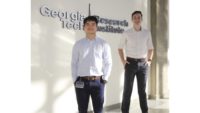Georgia Tech Research Institute introduces innovative dynamic filtration system
In this video Q&A, John Pierson, Principal Research Engineer, explains the new innovative dynamic filtration system and where it is in the process of getting the system to the marketplace.
Andy Hanacek: So John, we are here at IPPE 2016 at the Georgia Tech Institute booth. Appreciate you joining me to talk about yet another initiative you guys are working on here. [You are] working on a lot of great innovations here as always. It’s a dynamic filtration system. So tell me a little bit about that project and what it is all about, what you are hoping to do with the system.
John Pierson: We started the project based around looking at chillers, because the industry was really interested in water reuse and water recycling. The guidelines say they need to improve the physical, chemical and biochemical aspects of the water. So we had interest in how might we do that better than what was in the marketplace. When we looked broadly at poultry processing, there was also an opportunity after secondary screen on the wastewater side. What we’ve tried to do is find a way that we might to improve water quality whether it’s in the plant or outside of the plant, so that you’d have savings at both of those locations and do it in a way that didn’t exist in the marketplace, and you might even be able to concentrate materials and gather some value-added products while you did it.
Hanacek: Don’t drill way down into how the system works, but give a top line [overview]. How does the system work? How is it different from other ideas out there?
Pierson: What happens with most filtration systems is they quickly blind the filter or the membrane, so the challenge becomes how do you keep that surface clean so you can keep the liquid throughput very high throughout the process. So what we’ve done is come up with a way to in essence do real time backwash. Almost on every volume of water that goes through, you can do a slight backwash, concentrate that material, remove it and keep what we call the flux rate higher. That’s in essence what we’re doing. By controlling the flow and by controlling the timing aspects, we think it’s innovative, and we don’t see anything like it in the marketplace.
Hanacek: What’s the progress? What’s the stage of development is this project at and is it something that processors can be hoping to look for soon?
Pierson: So we’ve actually gathered enough data and done some preliminary work in it that we have a full patent application on the technology. One of things we’re interested here at the show is finding potential licensing partners, so we’ve been talking to a variety of manufacturers. That’s the thing, as a university, you can develop the technology and get it to the point where you’ve got a working prototype, and we think we know how we would actually produce one, but we really need to partner with the folks who would have it in the marketplace for the industry so we can work with them, make sure it addresses industry issues but is also built and designed and manufactured in a way that is cost-effective for the industry. So I think we’re at that point. We are looking for licensing partners, and I think hopefully in the next year or two, we might have a system that is ready to go.
Looking for a reprint of this article?
From high-res PDFs to custom plaques, order your copy today!





